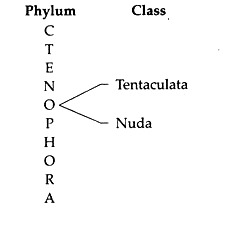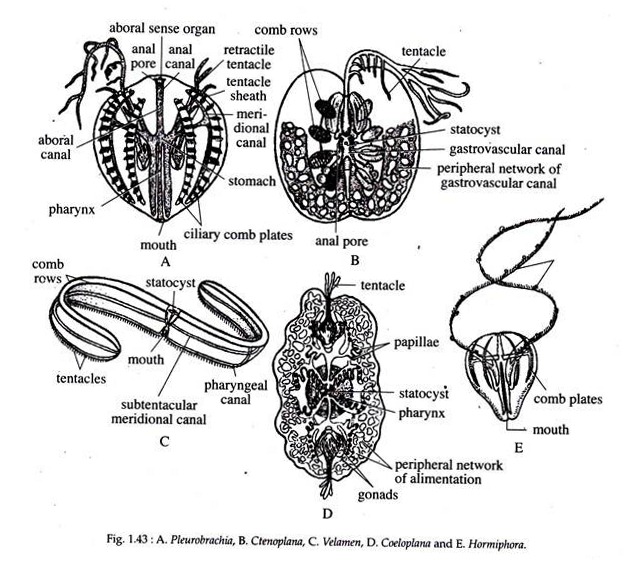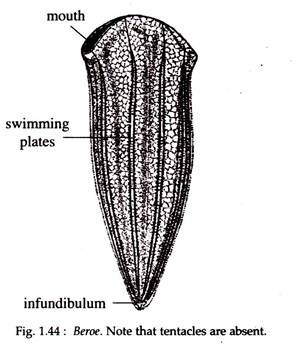In this article we will discuss about the Phylum Ctenophora:- 1. Classification of Phylum Ctenophora 2. Diagnostic Features of Phylum Ctenophora 3. Scheme of Classification 4. Systematic Resume.
Classification of Phylum Ctenophora:
The Ctenophorans are a small group of free-swimming, planktonic marine animals with transparent, delicate, gelatinous bodies. They are commonly known as sea walnuts or comb jellies. About 50 known species are present in this phylum and are abundant in coastal water.
Etymology:
Greek: ktenos, comb; phoros, bearing
Diagnostic Features of Phylum Ctenophora:
ADVERTISEMENTS:
i. Exclusively marine; mainly pelagic.
ii. The radial symmetry is rendered biradial by two tentacles (radial + bilateral).
iii. Body wall two layered; mesoglea is thick and has amoebocytes and smooth muscle fibres.
iv. Cnidocytes absent but tentacles carry Tasso cells (colloblasts).
ADVERTISEMENTS:
v. Eight meridional rows of ciliary plates are present which help in locomotion.
vi. Carnivorous animals having gastro-vascular cavity with mouth and anal pore.
vii. Respiratory exchange takes place by diffusion.
viii. Presence of luminescence.
ADVERTISEMENTS:
ix. Nervous system is in the form of a sub-epidermal nerve network which is particularly well developed beneath the comb rows.
x. Hermaphrodite; a few reproduce asexually. Cleavage complete, determinate type, leading ultimately to a ‘cydippid’ larva.
Scheme of Classification of Phylum Ctenophora:
The first definite description of ctenophores was given by Martens (1671). It was Hatschek (1839) who put all the ctenophores under a distinct phylum. Nearly all authors have divided ctenophores into two classes, the Tentaculate (six orders) and the Nuda (beroids only).
Parker and Haswell, 1972 (as revised by Marshall and Williams, 7th edn.), has also divided ctenophores into 2 classes — Tentaculata (Micropharyngea) and Nuda (Macropharyngea).
However, according to Meglitsch and Schram (1991), as the groups are poorly known, separation at the class level was not attempted. The classification followed in this text is after Ruppert and followed in this text is after Ruppert and Barnes, 1994 (6th edn).
Systematic Resume of Phylum Ctenophora:
Class Tentaculata:
i. The members of this class possesses two tentacles.
ADVERTISEMENTS:
ii. It is divided into 4 orders.
Examples: Hormiphore (Fig. 1.43E), Cestum and Velamen (Venus’s girdle) (Fig. 1.43C), Pleurobrachia (Fig. 1.43A), Ctenoplana (Fig. 1.43B), Coeloplana (Fig. 1.43D), Bolinopsis.
Class Nuda:
i. The representatives of this class lacks tentacles.
ii. It includes only one order.
iii. They are predators on other ctenophores.
Example: Beroe (Fig. 1.44).


